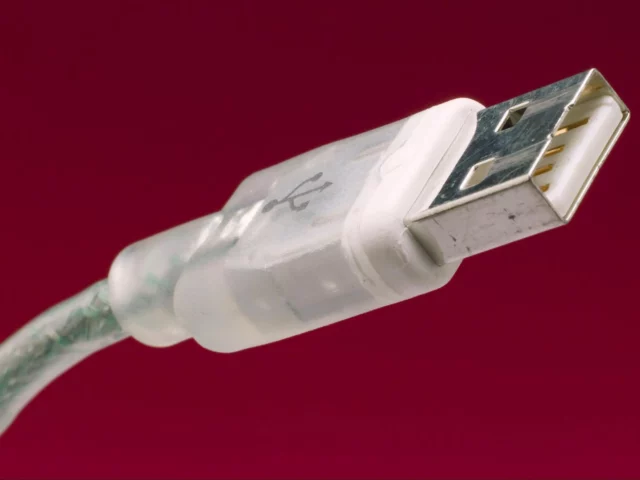
How USB Came to Be – Intel’s 26-year-old plug-and-play tech made it easy to connect everything
Article by Joanna Goodrich, IEEE Spectrum
 This USB cable was used in 2003 to connect a keyboard to Apple’s G4 computer. SSPL/GETTY IMAGES
This USB cable was used in 2003 to connect a keyboard to Apple’s G4 computer. SSPL/GETTY IMAGES
Today even the least tech-savvy consumers can attach a camera, printer, scanner, or other accessory to their PC effortlessly. But in the early 1990s, attaching a peripheral to a computer was not so simple.
Before the development of USB (Universal Serial Bus), it was often tricky to connect external devices. Users sometimes needed to open up their computer and add hardware to give them the communications port they needed.
The Universal Serial Bus, which was released in 1996 by Intel, simplified things. USB ports now are standard on personal computers and are built into many other electronic devices such as smartphones, eBook readers, and game consoles.
The ubiquitous USB standard has been commemorated with an IEEE Milestone. The IEEE Oregon Section sponsored the nomination. The dedication ceremony is still being planned.
Administered by the IEEE History Center and supported by donors, the Milestone program recognizes outstanding technical developments around the world.
“I thought [USB] was a [one-off US] $40 million opportunity,” Ajay Bhatt, one of the engineers at Intel who helped develop it, said in a 2013 interview with CNN about the technology. “I couldn’t imagine where USB has gone or where it will continue to go. This has exceeded the wildest of my imaginations.”
COLLABORATION IS KEY
Many of the problems consumers encountered when they tried to attach peripherals to their computer in the 1990s arose because of the lack of standard practices among the industry’s many suppliers, as noted in the Milestone’s entry on the Engineering and Technology History Wiki. Another problem was that most PCs had a limited number of input ports, and adding more could be difficult.
 Bhatt says that even as a technologist, he struggled with upgrading his PC.
Bhatt says that even as a technologist, he struggled with upgrading his PC.
“I looked at the architecture, and I thought, ‘You know what? There are better ways of working with computers, and this is just too difficult,’” he said in a 2019 interview with Fast Company.
In the early 1990s, Bhatt told his boss about his idea of developing a universal “plug -and-play” communication system—something the user didn’t need to adjust. His manager wasn’t interested.
Bhatt was passionate about his idea, though, so he decided to join a different
Ajay Bhatt is one of the engineers at Intel who helped develop USB.
PRADEEP GAUR/MINT/GETTY IMAGES
research team at Intel. And there he was given the green light.
In 1992 Bhatt visited the Jones Farm Conference Center, in Hillsboro, Ore., where he met with engineers from different tech companies who also were looking into developing a plug-and-play scheme. It was there that engineers from Compaq, Digital Equipment Corp. (DEC), IBM, Intel, Microsoft,NEC, andNortel formed an alliance.
“The industry as a whole recognized that it had a big problem that needed to be solved,” Jim Pappas said in an Intel article on the USB interface. At the time of the meeting, Pappas was an engineering manager at DEC, but he eventually joined Intel as a program manager for its USB-development team.
FROM DREAM TO REALITY
Before the group began developing USB, it explored what was already available. It looked at Ethernet-like technologies, audio interfaces, Apple’s GeoPort, and IEEE 1394—also known as the Firewire standard. But none had all the traits the team sought. In particular, the engineers wanted something that was inexpensive, user-friendly, able to power peripherals, and offered a lot of bandwidth.
This article appeared first at IEEE Spectrum on Feb 22, 2022.
–––
1 Comment





This story used the USB IEEE Milestone proposal that I wrote as its starting point. A bronze Milestone plaque will eventually be mounted in the lobby of the Jones Farm Conference Center (JFCC) on Intel’s Jones Farm Campus where the early USB development and collaborative testing was done by companies and individuals from around the world, leadiing up to the release of the USB 1.0 spec in January 1996, and work well beyond that date happened there as well. The proposal is at https://ieeemilestones.ethw.org/Milestone-Proposal:Universal_Serial_Bus_(USB)